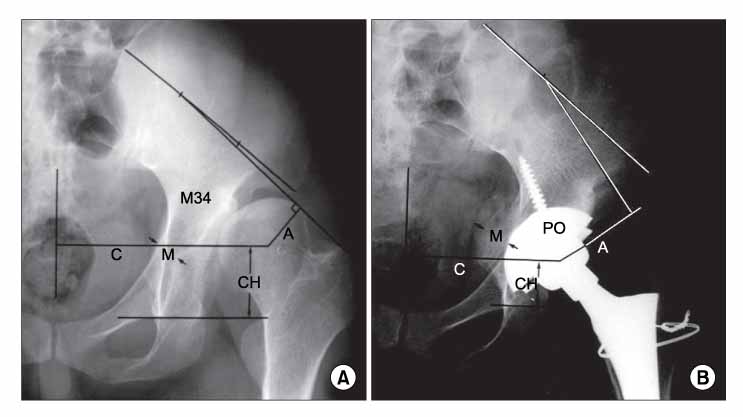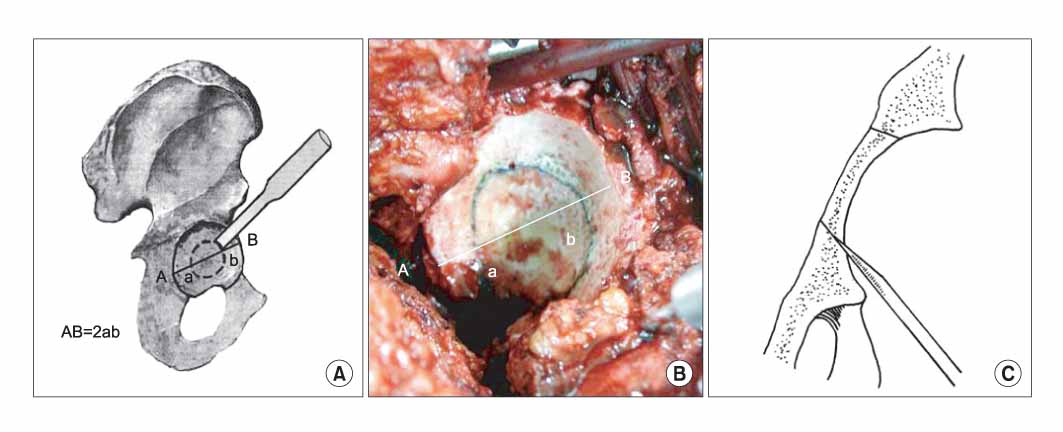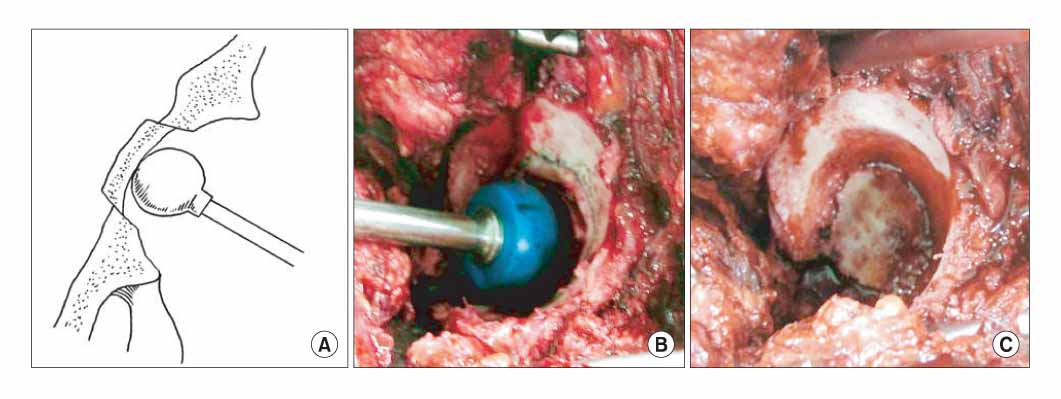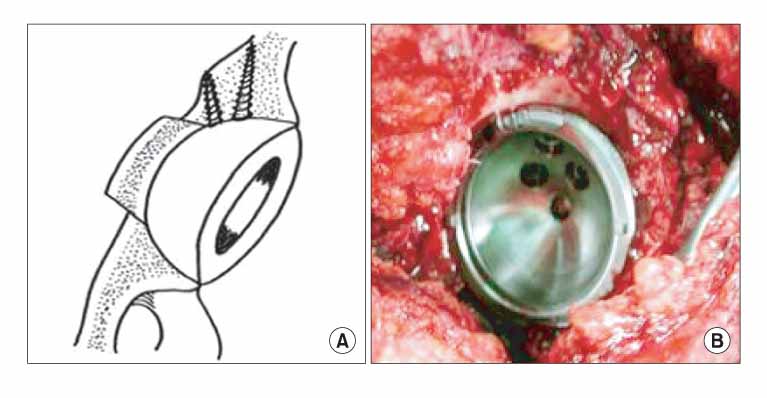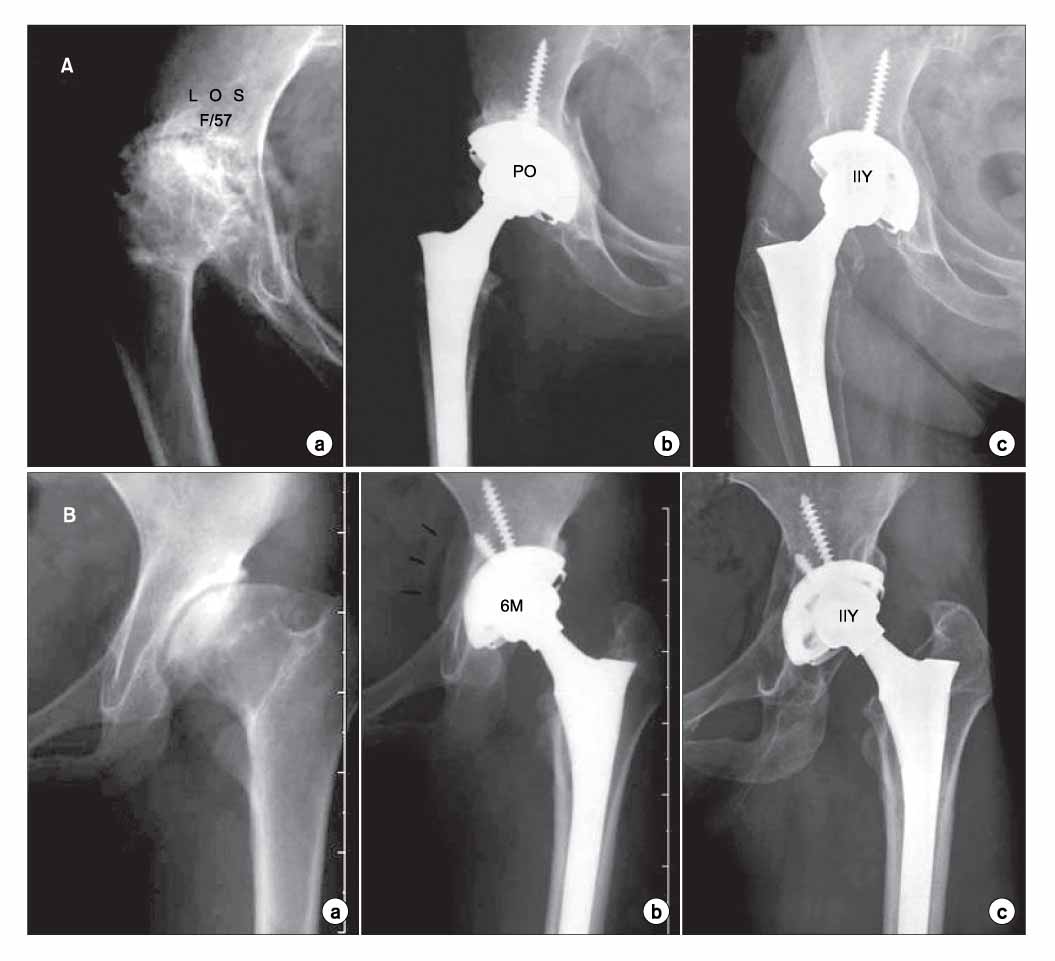Clin Orthop Surg.
2009 Mar;1(1):19-26. 10.4055/cios.2009.1.1.19.
Cementless Total Hip Arthroplasty with Medial Wall Osteotomy for the Sequelae of Septic Arthritis of the Hip
- Affiliations
-
- 1Department of Orthopaedic Surgery, College of Medicine, Kyung Hee University, Seoul, Korea. yjcho@khmc.or.kr
- KMID: 1127910
- DOI: http://doi.org/10.4055/cios.2009.1.1.19
Abstract
-
BACKGROUND: We performed a retrospective study to evaluate the results of acetabular circumferential medial wall osteotomy, a procedure designed to provide secure fixation of a cementless hemispherical acetabular cup for the sequelae of septic arthritis of the hip.
METHODS
We assessed 38 total hip arthroplasties (THAs) with circumferential acetabular medial wall osteotomies performed on patients with sequelae of septic arthritis of the hip between 1993 and 2000, who were followed up for > or = 3 years. The average follow-up period was 8.3 years (range, 3 to 12 years). The indication for this technique was poor acetabular cup coverage of < or = 70% on preoperative templating. In all cases, cementless hemispherical acetabular cups were fixed to the true acetabulum. Additional procedures included soft tissue release in 16 hips and femoral derotational and shortening osteotomies in 12 hips. We evaluated both clinical and radiological results.
RESULTS
The Harris hip scores improved from 57 points preoperatively to 91 points postoperatively. Radiological analysis revealed no aseptic loosening or radiolucent lines around the acetabular cup. Stable bony fixation of the acetabular cup in the true acetabulum was seen in all cases. Acetabular osteolysis was demonstrated in 12 hips. Revision surgery was performed in 6 hips, but there were no complications related to acetabular circumferential medial wall osteotomy.
CONCLUSIONS
Circumferential acetabular medial wall osteotomy can provide appropriate positioning and sufficient coverage of the acetabular cup and thus preserve the medial wall thickness in cementless THA without the need for additional bone grafting for the sequelae of septic arthritis of the hip.
Keyword
MeSH Terms
Figure
Reference
-
1. Hwang DS. Total hip arthroplasty in dysplastic hips. J Korean Hip Soc. 2002. 14(4):262–266.2. Linde F, Jensen J. Socket loosening in arthroplasty for congenital dislocation of the hip. Acta Orthop Scand. 1988. 59(3):254–257.
Article3. Crowe JF, Mani VJ, Ranawat CS. Total hip replacement in congenital dislocation and dysplasia of the hip. J Bone Joint Surg Am. 1979. 61(1):15–23.
Article4. Kerboull M, Hamadouche M, Kerboull L. Total hip arthroplasty for Crowe type IV developmental hip dysplasia: a long-term follow-up study. J Arthroplasty. 2001. 16(8 Suppl 1):170–176.
Article5. Kim YY, Ahn JY, Sung YB, et al. Total hip arthroplasties with high dislocation in tuberculous hip and developmental dysplasia of the Hip. J Korean Orthop Assoc. 2003. 38(3):273–281.
Article6. Tronzo RG, Okin EM. Anatomic restoration of congenital hip dysplasia in adulthood by total hip displacement. Clin Orthop Relat Res. 1975. (106):94–98.
Article7. Wilson MG, Nikpoor N, Aliabadi P, Poss R, Weissman BN. The fate of acetabular allografts after bipolar revision arthroplasty of the hip: A radiographic review. J Bone Joint Surg Am. 1989. 71(10):1469–1479.
Article8. Dunn HK, Hess WE. Total hip reconstruction in chronically dislocated hips. J Bone Joint Surg Am. 1976. 58(6):838–845.
Article9. Hartofilakidis G, Stamos K, Karachalios T. Treatment of high dislocation of the hip in adults with total hip arthroplasty: Operative technique and long-term clinical results. J Bone Joint Surg Am. 1998. 80(4):510–517.
Article10. Hess WE, Umber JS. Total hip arthroplasty in chronically dislocated hips: Follow-up study on the protrusio socket technique. J Bone Joint Surg Am. 1978. 60(7):948–954.
Article11. Livermore J, Ilstrup D, Morrey B. Effect of femoral head size on wear of the polyethylene acetabular component. J Bone Joint Surg Am. 1990. 72(4):518–528.
Article12. McQueary FG, Johnston RC. Coxarthrosis after congenital dysplasia. Treatment by total hip arthroplasty without acetabular bone-grafting. J Bone Joint Surg Am. 1988. 70(8):1140–1144.
Article13. Harris WH, Crothers O, Oh I. Total hip replacement and femoral-head bone-grafting for severe acetabular deficiency in adults. J Bone Joint Surg Am. 1977. 59(6):752–759.
Article14. Shetty AA, Sharma P, Singh S, Tindall A, Kumar SV, Rand C. Bulk femoral-head autografting in uncemented total hip arthroplasty for acetabular dysplasia: results at 8 to 11 years follow-up. J Arthroplasty. 2004. 19(6):706–713.
Article15. Yoo MC, Cho YJ, Kim KI, Chun YS, Sin DJ, Bae SC. Acetabuloplasty (shelf reconstruction) using structural bone graft in cementless total hip arthroplasty. J Korean Hip Soc. 2002. 14(3):194–202.16. Davlin LB, Amstutz HC, Tooke SM, Dorey FJ, Nasser S. Treatment of osteoarthrosis secondary to congenital dislocation of the hip. Primary cemented surface replacement compared with conventional total hip replacement. J Bone Joint Surg Am. 1990. 72(7):1035–1042.
Article17. Charnley J, Feagin JA. Low-friction arthroplasty in congenital subluxation of the hip. Clin Orthop Relat Res. 1973. (91):98–113.
Article18. Gerber SD, Harris WH. Femoral head autografting to augment acetabular deficiency in patients requiring total hip replacement. A minimum five-year and an average seven-year follow-up study. J Bone Joint Surg Am. 1986. 68(8):1241–1248.
Article19. Jasty M, Anderson MJ, Harris WH. Total hip replacement for developmental dysplasia of the hip. Clin Orthop Relat Res. 1995. (311):40–45.20. Mulroy RD Jr, Harris WH. Failure of acetabular autogenous grafts in total hip arthroplasty. Increasing incidence: a follow-up note. J Bone Joint Surg Am. 1990. 72(10):1536–1540.
Article21. Spangehl MJ, Berry DJ, Trousdale RT, Cabanela ME. Uncemented acetabular components with bulk femoral head autograft for acetabular reconstruction in developmental dysplasia of the hip: results at five to twelve years. J Bone Joint Surg Am. 2001. 83(10):1484–1489.
Article22. Johnston RC, Brand RA, Crowninshield RD. Reconstruction of the hip. A mathematical approach to determine optimum geometric relationships. J Bone Joint Surg Am. 1979. 61(5):639–652.
Article23. Russotti GM, Harris WH. Proximal placement of the acetabular component in total hip arthroplasty: A long-term follow-up study. J Bone Joint Surg Am. 1991. 73(4):587–592.
Article24. Woolson ST, Harris WH. Complex total hip replacement for dysplastic or hypoplastic hips using miniature or microminiature components. J Bone Joint Surg Am. 1983. 65(8):1099–1108.
Article25. Jacob HA, Huggler AH, Dietschi C, Schreiber A. Mechanical function of subchondral bone as experimentally determined on the acetabulum of the human pelvis. J Biomech. 1976. 9(10):625–627.
Article26. Dorr LD, Tawakkol S, Moorthy M, Long W, Wan Z. Medial protrusio technique for placement of a porous-coated, hemispherical acetabular component without cement in a total hip arthroplasty in patients who have acetabular dysplasia. J Bone Joint Surg Am. 1999. 81(1):83–92.
Article27. Torisu T, Izumi H, Fujikawa Y, Masumi S. Bipolar hip arthroplasty without acetabular bone-grafting for dysplastic osteoarthritis: Results after 6-9 years. J Arthroplasty. 1995. 10(1):15–27.
Article
- Full Text Links
- Actions
-
Cited
- CITED
-
- Close
- Share
- Similar articles
-
- Acetabular Medial Wall Displacement Osteotomy in Total Hip Arthroplasty for Dysplastic Hips
- Cementless Total Hip Arthroplasty using Cone Prosthesis for Childhood Septic Hip Sequelae
- Colonna Greater Trochanteric Arthroplasty for Septic Hip Sequelae: Long-term Follow-up of Two Cases
- Implant Design in Cementless Hip Arthroplasty
- Intrapelvic Mass with Calcific Density Wall after Total Hip Arthroplasty : A Report of Two Cases

